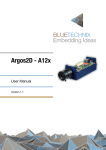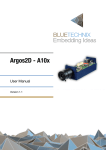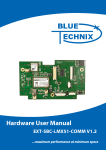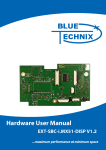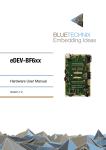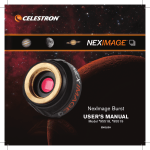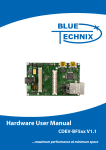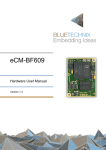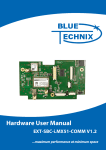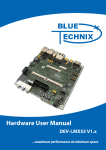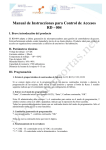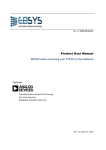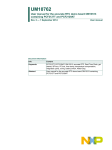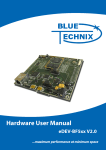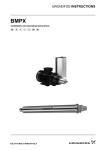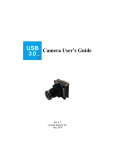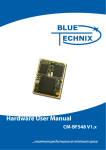Download Argos2D - D12x
Transcript
Argos2D - D12x User Manual Version 1.1 Bluetechnix GmbH Waidhausenstraße 3/19 A-1140 Vienna AUSTRIA office@bluetechnix.com www.bluetechnix.com Argos®2D – D12x – User Manual Document No.: 900-308 / B Publication date: June 28, 2013 Subject to change without notice. Errors excepted. This document is protected by copyright. All rights reserved. No part of this document may be reproduced or transmitted for any purpose in any form or by any means, electronically or mechanically, without expressly written permission by Bluetechnix GmbH. Windows is a registered trademark of Microsoft. Blackfin® is a registered trademark of Analog Devices, Inc. © Bluetechnix 2013 Table of Contents 1 General Information .......................................................................................................................... 5 1.1 2 Overview ........................................................................................................................................... 6 2.1 System Architecture .................................................................................................................. 6 2.2 Models ....................................................................................................................................... 6 2.2.1 Argos2D – D120 (150-1020-1) ........................................................................................... 7 2.2.2 Argos2D – D121 (150-1021-1) ........................................................................................... 7 2.2.3 Argos2D – D122 (150-1022-1) ........................................................................................... 7 2.2.4 Argos2D – D123 (150-1023-1) ........................................................................................... 7 2.2.5 Argos2D – D124 (150-1024-1) ........................................................................................... 7 2.3 3 4 Symbols Used ........................................................................................................................... 5 Interfaces & Connectors ........................................................................................................... 7 Software Installation ......................................................................................................................... 9 3.1 Software-Development-Kit SDK ............................................................................................... 9 3.2 Drivers ....................................................................................................................................... 9 3.3 Console ..................................................................................................................................... 9 Hardware Installation ..................................................................................................................... 10 4.1 Connecting the Core Module and the Carrier Board .............................................................. 10 4.2 Connecting CM and CB with housing base ........................................................................... 10 4.3 Connecting the ISM with front plane ...................................................................................... 11 4.4 Connecting the 30pin flex-foil cable to the ISM ..................................................................... 12 4.5 Connecting ISM to housing base ........................................................................................... 12 4.6 Inserting the µSD-Card and the coin cell ................................................................................ 13 4.7 Connecting the housing cover with the base ......................................................................... 14 5 Getting Started ............................................................................................................................... 15 6 Programming Environment ............................................................................................................ 16 Use Visual DSP++ Version 5.0 Update 8. .......................................................................................... 16 6.1 7 Setting up the tool chain ......................................................................................................... 16 Appendix ........................................................................................................................................ 17 7.1 Electrical Specifications .......................................................................................................... 17 7.1.1 Operating Conditions ....................................................................................................... 17 7.1.2 Maximum Ratings ............................................................................................................ 17 7.1.3 ESD Sensitivity ................................................................................................................. 17 7.2 Connector and Interface Description ...................................................................................... 17 7.2.1 Reset button b (S2) .......................................................................................................... 17 7.2.2 Analog video connector c (X9) ......................................................................................... 18 7.2.3 Power connector d (X4) ................................................................................................... 18 © Bluetechnix 2013 7.2.4 RJ45 Ethernet connector a (X3) ....................................................................................... 18 7.2.5 Status LED e (V3) ............................................................................................................. 18 7.2.6 Micro USB connector f (X7) ............................................................................................. 18 7.2.7 ISM connector g (X1) ....................................................................................................... 18 7.2.8 µSD-Card holder m (X5) .................................................................................................. 19 7.2.9 JTAG connector h (X2)..................................................................................................... 19 7.2.10 I/O extender connector k (X6).......................................................................................... 19 7.2.11 RTC-battery holder l (G1)................................................................................................. 20 7.2.12 Reset button i (S1) ........................................................................................................... 20 7.2.13 Boot mode switch j (S6) .................................................................................................. 20 7.2.14 Core Module connectors o (U1) ...................................................................................... 20 7.3 Mechanical Outline.................................................................................................................. 21 7.4 Support ................................................................................................................................... 21 7.4.1 General Support............................................................................................................... 21 7.4.2 Board Support Packages ................................................................................................ 21 7.4.3 Blackfin® Software Support ............................................................................................ 21 7.4.4 Blackfin® Design Services................................................................................................ 22 7.5 Dependability .......................................................................................................................... 22 7.5.1 8 Product History .............................................................................................................................. 23 8.1 9 MTBF ............................................................................................................................... 22 Version Information ................................................................................................................. 23 8.1.1 Argos2D – D120 (150-1020-1) ......................................................................................... 23 8.1.2 Argos2D – D121 (150-1021-1) ......................................................................................... 23 8.1.3 Argos2D – D122 (150-1022-1) ......................................................................................... 23 8.1.4 Argos2D – D123 (150-1023-1) ......................................................................................... 23 8.1.5 Argos2D – D124 (150-1024-1) ......................................................................................... 23 8.2 Anomalies ................................................................................................................................ 24 8.3 Document Revision History .................................................................................................... 24 Index ............................................................................................................................................... 25 © Bluetechnix 2013 © Bluetechnix GmbH 2013 All Rights Reserved. The information herein is given to describe certain components and shall not be considered as a guarantee of characteristics. Terms of delivery and rights of technical change reserved. We hereby disclaim any warranties, including but not limited to warranties of non-infringement, regarding circuits, descriptions and charts stated herein. Bluetechnix makes and you receive no warranties or conditions, express, implied, statutory or in any communication with you. Bluetechnix specifically disclaims any implied warranty of merchantability or fitness for a particular purpose. Bluetechnix takes no liability for any damages and errors causing of the usage of this board. The user of this board is responsible by himself for the functionality of his application. He is allowed to use the board only if he has the qualification. More information is found in the General Terms and Conditions (AGB). Information For further information on technology, delivery terms and conditions and prices please contact Bluetechnix (http://www.bluetechnix.com). Warning Due to technical requirements components may contain dangerous substances. © Bluetechnix 2013 Hardware User Manual - Argos2D - D12x 1 Last change: 28 June 2013 Version 1.1 General Information This guide applies to all smart cameras based on the Argos® smart camera platform from Bluetechnix GmbH. Follow this guide chapter by chapter to set up and understand your product. If a section of this document only applies to certain camera models, this is indicated at the beginning of the respective section. 1.1 Symbols Used This guide makes use of a few symbols and conventions: Warning Indicates a situation which, if not avoided, could result in minor or moderate injury and/or property damage or damage to the device. Caution Indicates a situation which, if not avoided, may result in minor damage to the device, in malfunction of the device or in data loss. Note Notes provide information on special issues related to the device or provide information that will make operation of the device easier. Procedures A procedure always starts with an headline 1. The number indicates the step number of a certain procedure you are expected to follow. Steps are numbered sequentially. This sign indicates an expected result of your action. References This symbol indicates a cross reference to a different chapter of this manual or to an external document. © Bluetechnix 2013 Page | 5 Hardware User Manual - Argos2D - D12x 2 Last change: 28 June 2013 Version 1.1 Overview 2.1 System Architecture The Argos2D – D12x is designed to cover the needs for an intelligent image sensor with a high flexibility in data transmission. The typical workflow can be divided in three actions: Video/Image processing • Data transmission ISM MT9M131-C MT9M025-M/C MT9M031-M/C eCM-BF609 2 x 600MHz 8MB NOR-Flash 256MB SDRAM Camera Interface • Cable Data capturing Camera Interface • DC-Plug Module USB-OTG Active Components Reset Buttons RGB LED RTC RGB-LED Driver µSD Card Slot JTAG Analog Video Encoder Cinch RJ45 Extension User Interfaces Connectors Figure 2.1: System Architecture The Bluetechnix standard Image Sensor Interface (BLT-ISM-Connector) allows connecting various image sensors to the Argos2D – D12x (i.e. ISM-AR0132AT, ISM-MT9M131 or ISM-MT9P031). To transmit the captured and processed data there are various interfaces on the Argos2D – D12x. Depending on the needed transmission rate you can select between USB, Ethernet, CAN (optional) or just store the data on a micro-SD-card. If there is the need to visualize the processed data or simply for visual debugging, an HDMI output is available on the Argos2D – D12x. 2.2 Models All Argos2D – D12x cameras are equipped with the i.MX carrier board, which contains all peripherals, the core module mount and interfaces including the ISM-connector, the eCM-BF609 SoM as CPU board, the housing and the selected ISM. © Bluetechnix 2013 Page | 6 Hardware User Manual - Argos2D - D12x Last change: 28 June 2013 Version 1.1 Front View a b c Side View c d e Back View f Figure 2.2: Argos2D – D12x views a. ISM (Images Sensor Module) changeable b. Front panel c. Lense holder d. Housing cover e. Housing base f. 2.2.1 Rear panel with user interface and peripherals connectors Argos2D – D120 (150-1020-1) The D120 comes with the MT9M131 color, image sensor form Aptina, module. The sensor has a 1/3-inch (5:4) format with 1280 x 1024 pixels. 2.2.2 Argos2D – D121 (150-1021-1) The D121 comes with the MT9M025 monochrome, image sensor form Aptina, module. The sensor has a 1/3inch (4:3) format with 1280 x 960 pixels. 2.2.3 Argos2D – D122 (150-1022-1) The D122 comes with the MT9M025 color, image sensor form Aptina, module. The sensor has a 1/3-inch (4:3) format with 1280 x 960 pixels. 2.2.4 Argos2D – D123 (150-1023-1) The D123 comes with the MT9P031 monochrome, image sensor form Aptina, module. The sensor has a 1/2.5-inch (4:3) format with 2592 x 1944 pixels. 2.2.5 Argos2D – D124 (150-1024-1) The D124 comes with the MT9P031 color, image sensor form Aptina, module. The sensor has a 1/2.5-inch (4:3) format with 2592 x 1944 pixels. 2.3 Interfaces & Connectors All Argos2D – D12x cameras are equipped with the same connectors and interfaces. © Bluetechnix 2013 Page | 7 Hardware User Manual - Argos2D - D12x Last change: 28 June 2013 Version 1.1 g c h i j k d d a c b a e f o l m n b e f Figure 2.3: Argos2D – D12x connectors and interfaces a. RJ45 Ethernet connector b. Reset button c. Analog video connector d. Power connector e. Status LED f. USB-OTG connector g. ISM connector h. JTAG connector i. Reset button j. Boot mode switch k. I/O extender connector l. RTC-battery holder m. µSD-Card holder n. Power supply LED o. Core Module connectors © Bluetechnix 2013 Page | 8 Hardware User Manual - Argos2D - D12x 3 3.1 Software Installation Last change: 28 June 2013 Version 1.1 Software-Development-Kit SDK Bluetechnix offers a Board Support Package that is based on BlackSheep. This BSP will need Visual DSP++ Version 5.0 Update 8. 3.2 Drivers If your Operating system does not install the drivers for a virtual comport, a USB-UART driver installation guide can be found here. 3.3 Console An installation guide for a serial console can be found here. © Bluetechnix 2013 Page | 9 Hardware User Manual - Argos2D - D12x 4 Hardware Installation Last change: 28 June 2013 Version 1.1 Caution Only assemble and dissemble electronic in an ESD-protected environment. 4.1 Connecting the Core Module and the Carrier Board 1. Put the carrier board with the bottom side up on a base. 2. Take the core module and align in on the connectors of the carrier board. Be aware that the CM and the CB is parallel 3. Connect the CM with appropriate force on the marked spots to the CB. 1 2 3 Figure 4.1: Connecting the Core Module and the Carrier Board 4.2 Connecting CM and CB with housing base 1. Take the rear plane and the housing base. 2. Take two M2.9 x 5mm self-tapping screws and mount it. 3. Take the eCM-CB compound with the CM looking down. First insert the connectors into the rear plane and then push the CB down to the housing base. 4. Take two M2.9 x 5mm self-tapping screws and mount it on the front. © Bluetechnix 2013 Page | 10 Hardware User Manual - Argos2D - D12x Last change: 28 June 2013 Version 1.1 3 1 2 4 Figure 4.2: Connecting CM and CB with housing base 4.3 Connecting the ISM with front plane 1. Usually the ISM comes mounted with a CS mount holder. This is fixed with two M2 x 5mm screws 2. Take the ISM and align it on the front plane, by using the locating pins. 3. Take four M2.9 x 8mm self-tapping screws and mount them together. 1 2 3 Figure 4.3: Connecting the ISM with front plane © Bluetechnix 2013 Page | 11 Hardware User Manual - Argos2D - D12x 4.4 Last change: 28 June 2013 Version 1.1 Connecting the 30pin flex-foil cable to the ISM 1. Take a look on the ISM. There is the possibility that more than one ISM connector is populated, if that’s the case you must use that one with an i.MX mark besides. The flex foil cable must have the contacts on the same side. 2. Pull out the lock of the connector with appropriate force simultaneously on both sides. 3. Insert the flex-foil cable with the visible contacts showing away from the ISM. 4. Secure the cable by pushing the lock back in. 1 2 3 4 5 Figure 4.4: Connecting flex-foil cable with ISM 4.5 Connecting ISM to housing base 1. Take the housing base including the CB and also take the ISM with connected front plane and flexfoil cable. 2. Pull out the lock of the connector with appropriate force simultaneously on both sides. 3. Pull out the lock of the connector with appropriate force simultaneously on both sides. 4. Insert the flex-foil cable with the visible contacts showing away from the ISM. 5. Secure the cable by pushing the lock back in. 6. Insert the ISM into the housing base 7. Turn the whole camera around and mount two M2.9 x 8mm self-tapping screws on the bottom. © Bluetechnix 2013 Page | 12 Hardware User Manual - Argos2D - D12x Last change: 28 June 2013 Version 1.1 1 2 3 4 5 6 7 Figure 4.5: Connecting ISM and front plane to housing base 4.6 Inserting the µSD-Card and the coin cell 1. Open the µSD-Card slot by pushing the slot with appropriate force to the right and then up. 2. Insert the µSD-Card. 3. Close the slot by pushing them town and to the left. 4. Push the 12mm coin cell with the positive side up and appropriate force into the holder. © Bluetechnix 2013 Page | 13 Hardware User Manual - Argos2D - D12x Last change: 28 June 2013 Version 1.1 4 1 2 3 Figure 4.6: Inserting the µSD-Card and the coin cell 4.7 Connecting the housing cover with the base 1. Put the housing cover over the base 2. Take two M2.9 x 8mm self-tapping screws and mount them in front of the cover. 3. Take two M2.9 x 18mm self-tapping screws and mount them in back of the cover. 2 1 3 Figure 4.7: Connecting the housing cover with the base © Bluetechnix 2013 Page | 14 Hardware User Manual - Argos2D - D12x 5 Getting Started Last change: 28 June 2013 Version 1.1 A Guide how to start with your Argos®2D D120 Camera based on the eCM-BF609 SoM can be found here. © Bluetechnix 2013 Page | 15 Hardware User Manual - Argos2D - D12x 6 Programming Environment Last change: 28 June 2013 Version 1.1 Use Visual DSP++ Version 5.0 Update 8. 6.1 Setting up the tool chain The tool chain gets installed with the Software-Development-Kit SDK. © Bluetechnix 2013 Page | 16 Hardware User Manual - Argos2D - D12x 7 Last change: 28 June 2013 Version 1.1 Appendix 7.1 7.1.1 Electrical Specifications Operating Conditions Symbol VIN IIN V3V3 I3V3 VOH VOL Parameter Input supply voltage Input current @ 12V Extender Voltage Supply Extender Current Supply High level output voltage Low level output voltage Min 7 3.0 2.31 - Typical 12 TBD 3.3 - Max1 20 TBD 3.6 TBD 0.99 Unit V mA V mA V V Table 7.1: Electrical characteristics 1 An overstepping of these maximums may cause permanent damage of the CM. 7.1.2 Maximum Ratings Stressing the device above the rating listed in the absolute maximum ratings table may cause permanent damage to the device. These are stress ratings only. Operation of the device at these or any other conditions greater than those indicated in the operating sections of this specification is not implied. Exposure to absolute maximum rating conditions for extended periods may affect device reliability. Symbol VIN VIO OH /IOL TAMB TSTO φAMB Parameter Input supply voltage Input or output voltage Current per pin Ambient temperature Storage temperature Relative ambient humidity Min -0.5 -0.5 0 0 -55 - Max 22 3.6 10 70 150 90 Unit V V mA °C °C % Table 7.2: Absolute maximum ratings 7.1.3 ESD Sensitivity ESD (electrostatic discharge) sensitive device. Charged devices and circuit boards can discharge without detection. Although this product features patented or proprietary protection circuitry, damage may occur on devices subjected to high energy ESD. Therefore, proper ESD precautions should be taken to avoid performance degradation or loss of functionality. 7.2 7.2.1 Connector and Interface Description Reset button b (S2) The push button performs a factory reset. This function is not implemented in Software. © Bluetechnix 2013 Page | 17 Hardware User Manual - Argos2D - D12x 7.2.2 Last change: 28 June 2013 Version 1.1 Analog video connector c (X9) The cinch connector provides a standard interface for analog video signals. The video encoder ADV7391 is preprocessing the video signal from the IPU. 7.2.3 Power connector d (X4) The Argos2D-D12x works with a single power supply of 7V to 20V. 7.2.4 RJ45 Ethernet connector a (X3) The RJ45 Ethernet connector is routed directly to the on-board physical transceiver of the eCM-BF609. 7.2.5 Status LED e (V3) The RGB LEDs are connected to GPIOs of the Core Module. LED Green Blue Red Signal PF23 PF24 PF22 Type Active low Active low Active low Table 7.3: Status LEDs e (V3) 7.2.6 Micro USB connector f (X7) The USB signals are routed to a micro USB-A connector. 7.2.7 ISM connector g (X1) Pin No. 1 2 3 4 5 6 7 8 9 10 11 12 13 14 15 16 17 18 19 20 21 22 Pin Name VCAMA GND SADDR CAMCLK NRESET SIO.C SIO.D VCAMC GND PCLK VSYNC HSYNC TRIGGER STROBE D0 D1 D2 D3 VCAMIO GND D4 D5 © Bluetechnix 2013 Signal Name VCAMIO GND CLKBUF PF16 PPI0.D15 PPI0.D15 GND PPI0.CLK PPI0.SY2 PPI0.SY1 PPI0.D12 PPI0.D13 PPI0.D0 PPI0.D1 PPI0.D2 PPI0.D3 VCAMIO GND PPI0.D4 PPI0.D5 Type PWR PWR NC O O O I/O NC PWR I I I O I I I I I PWR PWR I I Description Camera Analog Voltage Supply Power Ground Not Connected Camera Master Clock Global Reset Configuration Bus Clock Line Configuration Bus Data Line Not Connected Power Ground Pixel Clock VSYNC HSYNC Camera Trigger Strobe Signal from Camera Pixel Data Pixel Data Pixel Data Pixel Data Camera IO Power Supply Power Ground Pixel Data Pixel Data Page | 18 Hardware User Manual - Argos2D - D12x Pin No. 23 24 25 26 27 28 29 30 Pin Name D6 D7 GND D8 D9 D10 D11 OE Last change: 28 June 2013 Version 1.1 Signal Name PPI0.D6 PPI0.D7 GND PPI0.D8 PPI0.D9 PPI0.D10 PPI0.D11 PF18 Type I I PWR I I I I O Description Pixel Data Pixel Data Power Ground Pixel Data Pixel Data Pixel Data Pixel Data Output Enable (Active Low) Table 7.4: ISM connector g (X1) 7.2.8 µSD-Card holder m (X5) The µSD-Card is connected to the Core Module by SPI interface. The signal PF3 is used as CS. A µSD-Card connector mounted on the top side of the board supports µSD cards. 7.2.9 JTAG connector h (X2) A JTAG connector provides a debug interface to the Core Module. Pin No. 1 2 3 4 5 6 7 8 9 10 11 12 13 14 Signal Name GND JTAG.nEMU GND Vref JTAG.TMS GND JTAG.TCK GND JTAG.nTRST GND JTAG.TDI GND JTAG.TDO Type PWR O PWR Passive I PWR I PWR I PWR I PWR O Description Power Ground Emulation (active low) Power Ground IO Reference Voltage (10kΩ resistor to 3.3V) Test Mode Selection Power Ground Test Clock Power Ground Test Reset (active low) Power Ground Test Data Input Power Ground Test Data Output Table 7.5: JTAG connector h (X2) 7.2.10 I/O extender connector k (X6) Pin No. 1 2 3 4 5 6 7 8 9 10 11 12 Signal Name UART.RXD I2C.D UART.TXD I2C.C GND GND 3V3 3V3 PF1 CAN.RXD PF2 CAN.TXD © Bluetechnix 2013 Type I I/O 3k PU O O 3k PU PWR PWR PWR PWR I/O I I/O O Description UART Receive Data I2C Data UART Transmit Data I2C Clock Power Ground Power Ground 3.3V 3.3V GPIO CAN Receive Data GPIO CAN Transmit Data Page | 19 Hardware User Manual - Argos2D - D12x Pin No. 13 14 15 16 Signal Name SPI.SCLK SPI.MISO PF4 SPI.MOSI Last change: 28 June 2013 Version 1.1 Type O I I/O O Description SPI CLK SPI MISO GPIO SPI MOSI Table 7.6: I/O extender connector k (X6) 7.2.11 RTC-battery holder l (G1) There is also a possibility to add a 12mm coin cell to keep the RTC (PCF2129) running. The Argos2D – D12x is delivered only with a coin cell holder but without a battery. 7.2.12 Reset button i (S1) The push buttons perform a hardware reset. 7.2.13 Boot mode switch j (S6) To set the right boot mode for the eCM-BF609, only the switches 1 and 2 are used; switches 3 and 4 are used for extended boot mode features when using other Core Modules with an eADP adapter. Switch Setting 1 2 3 4 1 2 3 4 1 2 3 4 1 2 3 4 On Off Boot Description Execute from16Bit external memory bypass ROM On Off Reserved On Off Boot from 8Bit Flash On Off Boot from SPI 16Bit Table 7-7: Boot mode settings 7.2.14 Core Module connectors o (U1) The two connectors are used to mount an eCM-BF609 Core Module on the Argos2D-D12x. For more information take a look into the eCM-BF609 Hardware User Manual. © Bluetechnix 2013 Page | 20 Hardware User Manual - Argos2D - D12x 7.3 Last change: 28 June 2013 Version 1.1 Mechanical Outline 57 All dimensions are given in mm. 57 55 143 Figure 7.1: Mechanical outline 7.4 7.4.1 Support General Support General support for products can be found at Bluetechnix’ support site https://support.bluetechnix.at/wiki 7.4.2 Board Support Packages Board support packages and software downloads are for registered customers only https://support.bluetechnix.at/software/ 7.4.3 7.4.3.1 Blackfin® Software Support BLACKSheep® OS BLACKSheep® OS stands for a powerfully and multithreaded real-time operating system (RTOS) originally designed for digital signal processing application development on Analog Devices Blackfin® embedded processors. This high-performance OS is based on the reliable and stable real-time VDK kernel from Analog Devices that comes with VDSP++ IDE. Of course BLACKSheep® OS is fully supported by all Bluetechnix Core-Modules and development hardware. © Bluetechnix 2013 Page | 21 Hardware User Manual - Argos2D - D12x 7.4.3.2 Last change: 28 June 2013 Version 1.1 LabVIEW You can get LabVIEW embedded support for Bluetechnix Core Modules by Schmid-Engineering AG http://www.schmid-engineering.ch. 7.4.3.3 uClinux You can get uClinux support (boot loader and uClinux) for Bluetechnix Core Modules at http://blackfin.uClinux.org. 7.4.4 Blackfin® Design Services Based on more than seven years of experience with Blackfin, Bluetechnix offers development assistance as well as custom design services and software development. 7.4.4.1 Upcoming Products and Software Releases Keep up to date with all product changes, releases and software updates of Bluetechnix at http://www.bluetechnix.com. 7.5 7.5.1 Dependability MTBF Please keep in mind that a part stress analysis would be the only way to obtain significant failure rate results, because MTBF numbers just represent a statistical approximation of how long a set of devices should last before failure. Nevertheless, we can calculate an MTBF of the Core Module using the bill of material. We take all the components into account. The PCB and solder connections are excluded from this estimation. For test conditions we assume an ambient temperature of 30°C of all Core Module components except the Blackfin® processor (80°C) and the memories (70°C). We use the MTBF Calculator from ALD (http://www.aldservice.com/) and use the reliability prediction MIL-217F2 Part Stress standard. Please get in touch with Bluetechnix (office@bluetechnix.com) if you are interested in the MTBF result. © Bluetechnix 2013 Page | 22 Hardware User Manual - Argos2D - D12x 8 Product History 8.1 8.1.1 Last change: 28 June 2013 Version 1.1 Version Information Argos2D – D120 (150-1020-1) Version 1.0.0 Component ISM CM CB Type ISM-MT9M131-Color (100-3202-2) eCM-BF609-C-C-Q25S256F8 (100-1217-1) eCAM-eCM-BF Carrier Board (100-2280-1) Table 8.1: Overview Argos2D – D120 product changes 8.1.2 Argos2D – D121 (150-1021-1) Version 1.0.0 Component ISM CM CB Type ISM-AR0132AT-Mono (100-3200-2) eCM-BF609-C-C-Q25S256F8 (100-1217-1) eCAM-eCM-BF Carrier Board (100-2280-1) Table 8.2: Overview Argos2D – D121 product changes 8.1.3 Argos2D – D122 (150-1022-1) Version 1.0.0 Component ISM CM CB Type ISM-AR0132AT-Color (100-3206-2) eCM-BF609-C-C-Q25S256F8 (100-1217-1) eCAM-eCM-BF Carrier Board (100-2280-1) Table 8.3: Overview Argos2D – D122 product changes 8.1.4 Argos2D – D123 (150-1023-1) Version 1.0.0 Component ISM CM CB Type ISM-MT9P031-Mono (100-3210-2) eCM-BF609-C-C-Q25S256F8 (100-1217-1) eCAM-eCM-BF Carrier Board (100-2280-1) Table 8.4: Overview Argos2D – D123 product changes 8.1.5 Argos2D – D124 (150-1024-1) Version 1.0.0 Component ISM CM CB Type ISM-MT9P031-Color (100-3204-2) eCM-BF609-C-C-Q25S256F8 (100-1217-1) eCAM-eCM-BF Carrier Board (100-2280-1) Table 8.5: Overview Argos2D – D124 product changes © Bluetechnix 2013 Page | 23 Hardware User Manual - Argos2D - D12x 8.2 Last change: 28 June 2013 Version 1.1 Anomalies Version V1.0.0 Date 2013 02 11 Description No anomalies reported yet. Table 8.6 – Product anomalies 8.3 Document Revision History Version 1 Date 2013 02 11 Document Revision First release V1.0 of the Document Table 8.7: Revision history © Bluetechnix 2013 Page | 24 Hardware User Manual - Argos2D - D12x 9 Last change: 28 June 2013 Version 1.1 Index B I Blackfin® Software Support · 21 BLACKSheep® OS · 21 Boot mode switch · 20 Interfaces & Connectors · 7 C M Connector and Interface Description · 17 Maximum Ratings · 17 MTBF Mean Time Between Failure · 22 E O ESD Electro Static Discharge · 17 Operating Conditions · 17 G Getting Started Quick start guide · 15 S Software Installation · 9 System Architecture General Overview · 6 H Hardware Installation · 10 © Bluetechnix 2013 Page | 25


























